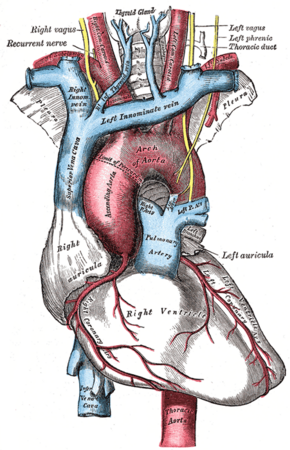Biology:Aortic body
| Aortic body | |
|---|---|
 The heart, thoracic aorta and other great vessels (aortic body not visible, but aortic arch labeled at center) | |
| Details | |
| Nerve | Vagus nerve |
| Identifiers | |
| Latin | Glomus aorticum, corpora paraaortica |
| Anatomical terminology | |
The aortic bodies are one of several small clusters of peripheral chemoreceptors located along the aortic arch. They are important in measuring partial pressures of oxygen and carbon dioxide in the blood, and blood pH.
Structure
The aortic bodies are collections of chemoreceptors present on the aortic arch.[1] Most are located above the aortic arch,[2] while some are located on the posterior side of the aortic arch between it and the pulmonary artery below.[3] They consist of glomus cells and sustentacular cells.[1]
Some sources equate the "aortic bodies" and "paraaortic bodies", while other sources explicitly distinguish between the two.[4][5] When a distinction is made, the "aortic bodies" are chemoreceptors which regulate the circulatory system, while the "paraaortic bodies" are the chromaffin cells which manufacture catecholamines.[6]
Function
The aortic bodies measure partial gas pressures and the composition of arterial blood flowing past it.[7] These changes may include:
- oxygen partial pressure.[7][8]
- carbon dioxide partial pressure.[7][8]
- pH (indirectly affected by carbon dioxide concentration).[1][8]
They are particularly sensitive to changes in pH.[2] Aortic bodies are more sensitive detectors of total arterial blood oxygen content than the carotid body chemoreceptors, which are more sensitive detectors of the partial pressure of oxygen in the arterial blood.[8]
The aortic bodies give feedback to the medulla oblongata, specifically to the dorsal respiratory group, via the afferent branches of the vagus nerve (cranial nerve X).[1][3] The medulla oblongata, in turn, regulates breathing and blood pressure.
Clinical significance
A paraganglioma, also known as a chemodectoma, is a tumor that may involve an aortic body.[9]
Swelling can also occur.[vague]
See also
- Carotid body
- Control of respiration
- Peripheral chemoreceptors
References
- ↑ 1.0 1.1 1.2 1.3 Russell, D. S. (2014-01-01), McManus, Linda M.; Mitchell, Richard N., eds., "Comparative Pathology: Cardiovascular System" (in en), Pathobiology of Human Disease (San Diego: Academic Press): pp. 1042–1070, doi:10.1016/b978-0-12-386456-7.03403-1, ISBN 978-0-12-386457-4, http://www.sciencedirect.com/science/article/pii/B9780123864567034031, retrieved 2021-01-01
- ↑ 2.0 2.1 Ahluwalia, N.; Owens, R. L.; Badr, S.; Malhotra, A. (2013-01-01), Kushida, Clete A., ed. (in en), Sleep and the Control of Breathing, Waltham: Academic Press, pp. 525–532, doi:10.1016/b978-0-12-378610-4.00109-1, ISBN 978-0-12-378611-1, http://www.sciencedirect.com/science/article/pii/B9780123786104001091, retrieved 2021-01-01
- ↑ 3.0 3.1 Kazemi, Homayoun; Johnson, Douglas C. (2002-01-01), Ramachandran, V. S., ed. (in en), Respiration, New York: Academic Press, pp. 209–216, doi:10.1016/b0-12-227210-2/00302-2, ISBN 978-0-12-227210-3, http://www.sciencedirect.com/science/article/pii/B0122272102003022, retrieved 2021-01-01
- ↑ Aortic+Bodies at the US National Library of Medicine Medical Subject Headings (MeSH)
- ↑ Para-Aortic+Bodies at the US National Library of Medicine Medical Subject Headings (MeSH)
- ↑ Piskuric, Nikol A.; Nurse, Colin A. (2013). "Expanding role of ATP as a versatile messenger at carotid and aortic body chemoreceptors". The Journal of Physiology 591 (2): 415–422. doi:10.1113/jphysiol.2012.234377. ISSN 0022-3751. PMID 23165772.
- ↑ 7.0 7.1 7.2 Balcombe, Jonathan; Torigian, Drew A.; Kim, Woojin; Miller, Wallace T. (2007-04-01). "Cross-Sectional Imaging of Paragangliomas of the Aortic Body and Other Thoracic Branchiomeric Paraganglia". American Journal of Roentgenology 188 (4): 1054–1058. doi:10.2214/AJR.05.1497. ISSN 0361-803X. PMID 17377046. https://www.ajronline.org/doi/full/10.2214/AJR.05.1497.
- ↑ 8.0 8.1 8.2 8.3 Prabhakar, Nanduri R. (2016-01-01), Zufall, Frank; Munger, Steven D., eds., "Chapter 18 - O2 and CO2 Detection by the Carotid and Aortic Bodies" (in en), Chemosensory Transduction (Academic Press): pp. 321–338, doi:10.1016/b978-0-12-801694-7.00018-4, ISBN 978-0-12-801694-7, http://www.sciencedirect.com/science/article/pii/B9780128016947000184, retrieved 2021-01-01
- ↑ Miller, Margaret A. (2017-01-01), Zachary, James F., ed., "Chapter 12 - Endocrine System1" (in en), Pathologic Basis of Veterinary Disease (Sixth Edition) (Mosby): pp. 682–723.e1, doi:10.1016/b978-0-323-35775-3.00012-6, ISBN 978-0-323-35775-3, http://www.sciencedirect.com/science/article/pii/B9780323357753000126, retrieved 2021-01-01
- REDIRECT Template:Arteries of thorax
 |

